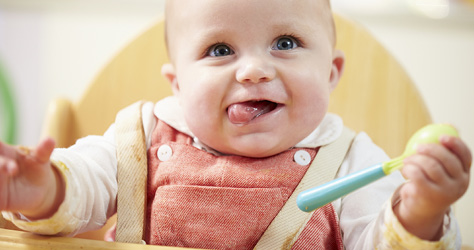Do you want to start your baby on smooth food or only give them finger foods right from the start?
Baby-led weaning involves you only letting your baby feed themselves finger food right from the get-go. Find out the pros and cons of this method of weaning.
At a glance
- Baby-led weaning (BLW) is when you let your baby feed themselves tasty finger foods right from the beginning
- Spoon-led weaning is when babies learn to swallow first (purées) and chew later
- Both approaches work well and you can choose the approach which suits you best

What is baby-led weaning?
Baby-led weaning (BLW) is when you let your baby feed themselves tasty finger foods right from the beginning - rather than starting off with spoon feeding smooth mash or purées and including finger foods around the same time or a bit later.
The main difference between baby-led and spoon-fed weaning is the order babies learn their feeding skills. With traditional weaning, babies learn to spoon feed first (smooth mashed food) and chew later. With baby-led weaning, babies skip the smooth food phase and learn to manage lumps and chew from the beginning.
How does exclusive baby-led weaning work?
You skip the smooth mashed food stage and offer your baby foods like bread fingers, cooked vegetables or pasta shapes they can grasp and move to their mouths. At around six months, most babies can sit in a highchair and tuck in.
Do I have to choose between baby-led weaning and spoon feeding?
Absolutely not and in fact, the NHS recommends you offer your baby a combination of mashed foods and finger foods from the beginning. You may find your baby prefers one way of feeding over the other but they will be learning both skills at the same time.
Why could baby-led weaning be good for my baby?
There are a number of benefits of baby-led weaning that are claimed by followers including:
- Adventurous palette - fans of baby-led weaning believe that babies who choose foods for themselves are less likely to turn into fussy eaters
- Ready for lumps - It’s also said the ‘finger fooders’ may be less likely to struggle with lumps than babies weaned on smooth purées
- Family meals - It’s also easier for the family to eat together - giving your baby a chance to learn by watching you eat and being part of family mealtimes
- Less work – it’s certainly means less work for you in terms of mashing or puréeing food
What are the downsides of baby-led weaning?
Letting your baby take control of feeding time unsurprisingly comes with a few downsides:
- Mess central - well, it can get madly messy, but it’s fun to watch!
- Time - it takes ages for them to consume a decent amount and you must stay with them in case of choking
- Unknown quantity – a lot goes on the floor and it is difficult to know how much your baby is actually eating – some mothers find their baby keeps demanding more and more milk as their baby is not getting enough to eat
How do I go about baby-led weaning?
Pop your baby in a highchair at mealtimes when the rest of your family are eating and offer them a small selection of foods that are easy to grasp.
You can put the food in front of them, or let them take it from you but regardless, ideal finger foods should be big enough for your baby to hold in their fist with some left sticking out of the top, so probably about the size of your finger and chip shaped.
For now they’ll only be able to grab food in their fist so food can’t been too small, although the size can be increased as the months go on.
Around six – eight months, you’ll want to try chunks of soft fruit, sticks of cooked carrot or strips of omelette. You might find that to begin with they spend a lot of time playing with or sucking on the pieces of food. Don’t worry too much if they don’t finish it all as you will carry on giving them the nutrients and energy they need from your breast milk or formula in between mealtimes.
Will baby-led weaning lead to choking?
Some mums worry their baby might choke on finger foods, and it’s certainly a good idea so to whip stones out of fruit and cut small fruits, like grapes, quarter them lengthwise. It’s vital you always stay with your baby while they’re eating anyway, in case they choke.